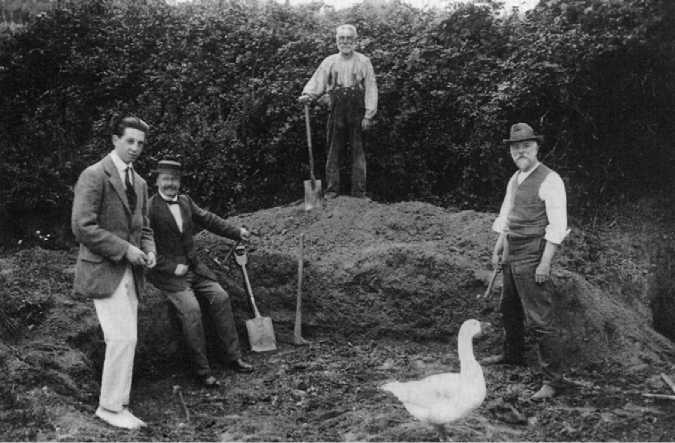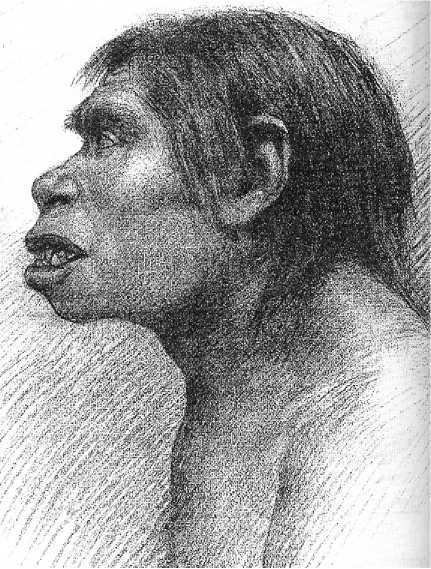There is no better known example, no more egregious case, no more influential instance, and no better model for archaeological fraud than that of Piltdown Man. To understand why it was such an enormous success, the context of its evolutionary implications, had it been genuine, must be addressed.
The second half of the nineteenth century and the early years of the twentieth were heady times for those pondering the origin of species, including the origin of our own. Charles Darwin’s watershed work, The Origin of Species by Means of Natural Selection, was published in 1859, just three years after a fossil calvarium (skull cap) had been found by workers building a roadway in the Neander Valley in Germany. The fossil’s find spot provided the name for the now well-known archaic variety of human beings, the Neandertals.
Beyond a passing remark in the final paragraphs of his seminal work, Darwin avoided applying his theory to human beings. This, however, did not prevent other scholars from contemplating the evolutionary implications of the discovery in the Neander Valley as well as the significance of other fossils found throughout Europe, Asia, and Africa that seemed to represent arcHaic, perhaps ancestral, varieties of human beings.
Many evolutionists in the nineteenth and early twentieth centuries embraced an evolutionary paradigm for human beings characterized as ‘brain centered’. Briefly, the brain-centered paradigm was based on the recognition that the characteristic that most clearly distinguishes us from other animal species is our great intelligence made possible by our large brains. The logical underpinning of the brain-centered paradigm can be phrased in this way: because humans exhibit the most significant difference from other creatures, including our nearest evolutionary relatives, the apes, in terms of brain size and configuration, it must have been the brain that first marked our departure from those relatives in our separate evolutionary trajectories. If the brain was our most changed, most highly developed feature, the argument went, it must have taken the longest to develop and, therefore, must have begun its divergence first. This perspective led thinkers to predict that in the fossil evidence of human evolution yet to be found in the late nineteenth and early twentieth centuries, researchers should find a large-brained version of what amounts to, in all other respects, a chimpanzee. This view is exemplified in the writing of Arthur Smith Woodward of the British Museum (Natural History), who maintained: ‘‘The growth of the brain preceded the refinement of the features and of the somatic characters in general.’’
The brain-centered paradigm was preferred, at least in part, because it allowed for the early evolution of our intelligence, our ability to think, to communicate, and to create. These are the things that truly define, distinguish, and separate us from other animals. It seemed sensible and, perhaps, it was comforting, to believe that the organ that made those human skills possible, our large brain, had been the priority of evolution.
The brain-centered paradigm, however, was continually challenged by palaeoanthropological data collected in the late nineteenth and early twentieth centuries. An ancient calvarium recovered in 1891 on the island of Java and estimated at the time to be more than 0.5 million years old, was too large to be that of an ape, but far too small to be a human being’s. Found nearby was a femur that appeared to be entirely modern in its configuration. Eugene Dubois, the Dutch physician who collected the specimens, concluded that the femur and calvarium belonged to the same individual, asserting that the ancient human ancestor, colloquially called Java Man, was small-brained and bipedal. An ancient human being with a human-like body - at least one capable of our uniquely bipedal locomotion - and an ape-like brain was precisely the opposite of what the brain-centered paradigm predicted.
Though the original Neandertal, and all subsequent specimens placed in the same category, were large brained, their crania reflected a morphology that seemed more ape-like than human, characterized by a sharply sloping forehead with little room for the forebrain, a flattened cranial profile unlike the modern human configuration which is tall and round, a forward-thrusting, muzzle-like lower face, and a substantial, continuous ridge of bone above the eye orbits. Though there was quite a bit of controversy concerning the precise nature of the Neandertal gait, their postcranial skeletons showed very clearly that they walked upright. So even at a fairly recent point in human evolution - no more than, perhaps, about 80 000 years ago - the Neandertals seemed more human below than above, again, the opposite of what the brain-centered paradigm predicted.
This detailed exposition provides context for the discovery in England of a fossil that called into quesTion the significance of the Java and Neandertal specimens and once again elevated the brain-centered paradigm to center stage in discussions of the process of human evolution. Tucked into a section of news announcements in the 5 December 1912 issue of the even then venerable British science weekly Nature, was the announcement by a Mr. Charles Dawson of the discovery in the Piltdown region of Sussex, in the south of England of ‘‘a human skull and mandible, considered to belong to the early Pleistocene period’’ (Figure 3).
Dawson was a lawyer by training, but, by disposition, was a dedicated collector of geological, palaeontological, and archaeological specimens. In fact,
Dawson was considered so lucky at finding such things, his envious colleagues nicknamed him, ‘‘the Wizard of Sussex’’. In publications, Dawson maintained that the first piece of cranium found in a pit at the Barcombe Mills Manor, had been handed to him in 1908 by workers gathering gravel. Four additional cranial fragments were obtained by Dawson in the same pit in 1911 whereupon he personally commenced the search for additional bones. Dawson was joined at the site in the summer of 1912 by previously mentioned British Museum scientist Arthur Smith Woodward and Pierre Teilhard de Chardin, a Jesuit priest with a lifelong interest in science in general and human evolution in particular. Working together, initially they found yet another human-like cranial fragment and the bones of a number of extinct animals. Later in that same summer, half of an ape-like mandible (lower jaw) was recovered from the same pit and still later a canine tooth that fits comfortably within the mandible was also found.
In 1914, the team found a large chunk of animal bone carved into a shape that seemed a remarkable match for the bat used in the British game of cricket. Called, in fact, the ‘‘cricket bat’’, no one suggested that ancient humans were playing the game in antiquity, but, at the same time, no one digging at Piltdown yet recognized that someone was having a good laugh at their expense.
As Dawson and Woodward emphasized in the first detailed published description of the discovery, the cranial fragments had come from a large, humanlike skull that also exhibited some primitive features, in particular, relatively thick cranial bones. The lower

Figure 3 Workers at the Piltdown Man site: Robert Kenward, Jr., a tenant of Barcombe Mills Manor; Charles Dawson (seated); workman Venus Hargreaves; Chipper, the goose; and Arthur Smith Woodward (Courtesy of The British Museum).

Figure 4 Artist’s depiction of Piltdown Man as it appeared in the Illustrated London News, January 11, 1913, New York Edition.
Jaw, on the other hand, was very ape-like, heavily buttressed by bone and lacking a human chin. The age of the specimens could not be determined precisely, but their stratigraphic context implied that they were far older than the Neandertals and likely older than Java Man (see Figure 4).
To some, the cranium and mandible represented the equivalent of a chimera, a monstrous and unnatural combination of parts of two distinctly different creatures. German scientist Franz Weidenreich went so far as to suggest that the cranial fragments and mandible were ‘‘the artificial combination of fragments of a modern-human braincase with an orangutan-like mandible and teeth’’. To others, however, the remains at Piltdown seemed to be just exactly what was necessary to revitalize the brain-centered paradigm: a creature with a brain of apparent modern human size and configuration, but with ape-like features below that modern brain.
The discovery at Piltdown grabbed the attention of the scientific community for several reasons. Certainly, the fact that it seemed to confirm the brain-centered paradigm preferred by many when all previous finds had contradicted it, was an enormously important part of its appeal. At the same time, the discovery at Piltdown provided for the British their first ancient human fossil. All the better, it must have felt to the British, that in Piltdown they had, not only their first important ancient human remain, but a specimen that Seemed to relegate the fossils found in other nations to side branches, diversions off the main trunk of human evolution. If humanity possessed, at the base of its evolutionary tree, a creature with a large, humanly configured brain, and an ape-like mandible and body, then more recent creatures, like Java or Neandertal Man, with their ape-like heads and human-like bodies, must have been unsuccessful and not terribly important creatures, backsliders off the main pathway leading toward humanity, in other words, evolutionary dead ends.
Where the Cardiff Giant had been a clumsy fraud that was unable to fool any scientists who examined it, Piltdown had to be more convincing, perhaps because it had to fool a much more skeptical, better informed, and more sophisticated primary audience - evolutionary scientists. Trained scientists they may have been, but like the public who accepted the Cardiff Giant, many of them suspended their skeptical sense and accepted the validity of the Piltdown fossil because it seemed to support a cherished belief - albeit a belief that related to science rather than a religion - the brain-centered paradigm.
The Piltdown fraud was not definitively exposed until 1953 when, through the application of fluorine/ nitrogen analysis (a relative dating procedure), the cranium and mandible were shown to be of entirely different ages. A close examination of the mandible confirmed the suspicion of some that it had been intentionally broken at the point of articulation between it and the cranium, apparently to prevent researchers from determining what should have been obvious, that the two bones didn’t belong to the same individual or, it as turns out, even the same species. Indeed, the cranial fragments were those of an anatomically modern human being; radiocarbon dating indicates that it was only about six-hundred years old. Franz Weidenreich had been precisely correct, however, about the lower jaw. The hoaxer had obtained the mandible of an orangutan, had broken off the condyle where it would have articulated with the cranium, and placed it in the same pit with the human cranial fragments.
Though many have been accused of perpetrating the Piltdown hoax, there is no definitive proof of who was responsible. Charles Dawson’s presence at every major discovery, his remarkable luck at finding the only seemingly confirming evidence (he claimed to have found the fossil fragments of another, similar creature, called Piltdown II, in 1915), a history of association with questionable discoveries, and the cessation of all related finds immediately upon his death seem convincing proof that he was, at least, a major player in the fraud. Whether he had professional help has been the focus of several investigations, not to mention books, and perhaps, the Piltdown ‘‘whodunit’’ has gotten to be, as archaeologist Christopher Chippendale puts it, a pointless Victorian parlor game.
It is of far greater importance to remember that while the definitive exposure of the fake did not occur until more than 40 years after the announcement of its discovery, Piltdown had, long before this, been relegated to the status of a curious footnote among palaeoanthropologists in their evolutionary scenarios. The frenzy of palaeoanthropological research that followed and was, at least in part, inspired by Piltdown’s discovery, resulted in not a single similar, confirming fossil, at least by anyone other than Charles Dawson. All subsequent discoveries in Europe, Asia, and Africa confirmed the evolutionary pattern exhibited by the Java and Neandertal discoveries; upright walking predated the modernization of the cranium and brain rather than the other way around. Revealing Piltdown as a fake in 1953 shocked few. It merely confirmed what many, by that time, suspected; Piltdown had been an egregious fake. Much as many wished to believe that the modern brain had begun its evolutionary trajectory into the modern form as the first step in human evolution, it simply was not the paradigm supported by the data.




 World History
World History









